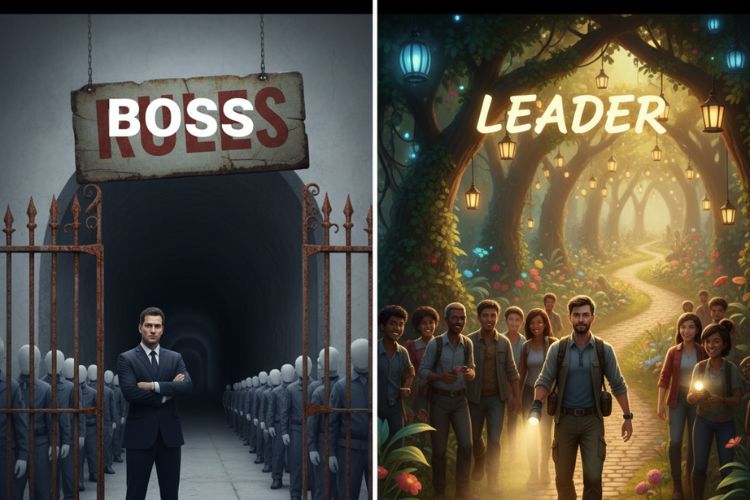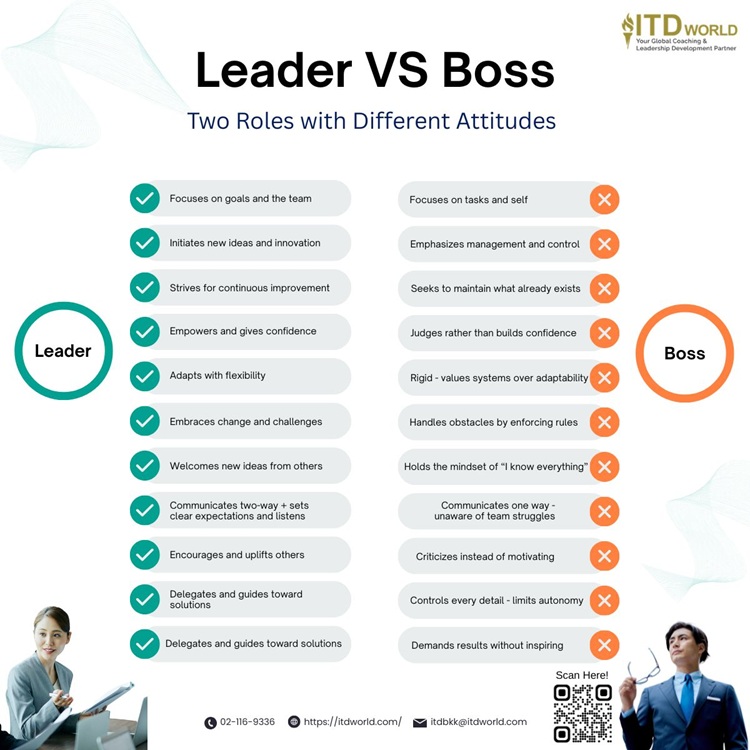Discover the 11 key differences between leader vs boss, plus how to identify your own behaviors and make the critical transition.
Does your team follow your directives out of compliance, or are they driven by a shared sense of commitment? The answer to this question will tell you whether you are a “boss” or a “leader“. While often used interchangeably in the business world, these two terms represent two fundamentally different approaches to management. Given a modern workforce that, generally speaking, values purpose over obedience, the old “command-and-control” boss mentality is failing, necessitating a shift toward a mindset that inspires and empowers.
(by Jonathan M. Pham)
Highlights
- A boss uses their formal authority and position to control tasks, whereas a leader uses influence and earned respect to inspire vision and empower people.
- To thrive in the modern workplace, organizations must urgently shift from the damaging “command and control” boss mentality to an empowering leader approach that attracts top talent, fosters innovation, and meets the new expectations of employees.
- A boss focuses on “I,” controls details, maintains the status quo, judges, and demands results through one-way, rigid communication; while a leader focuses on “we,” delegates effectively, strives for improvement, empowers, and guides toward solutions through two-way, flexible communication.
- The transition from being a boss to becoming a leader requires honest self-assessment of one’s habits and a conscious commitment to growth by practicing empathy, active listening, empowerment, focusing on people development, and modeling integrity and consistency.
Leader vs Boss: A Quick Definition
While both roles involve managing people and driving results, their source of power and core focus are worlds apart.
- The “Boss”: A boss operates primarily through formal authority. Their power comes directly from their position and title on the organizational chart. As such, their mindset is typically focused on control, managing processes, and ensuring tasks are completed according to a set standard. Team members obey them because they have to.
- The “Leader”: A leader guides primarily through influence and inspiration. Their power is not given; it is earned through the credibility, trust, and respect they actively nurture with their people. Their main focus is on vision, cultivating potential, and empowering the team. As a result, team members follow them because they want to.
Why “Leader” is More Than a Title
This distinction brings up two critical questions:
- Can you be a boss but not a leader?
Yes, absolutely. “Boss” (or manager, supervisor, etc.) is a title that is given to you. It grants you formal authority. “Leader,” however, is a status that you must earn from your team through daily actions.
Many people in management positions have the title of “boss” – but have not yet earned the status of “leader”, because they have not successfully connected with their people.
- Is a leader “higher” than a boss?
No, the relationship to the team is different. A boss typically positions themselves above the team, handing down directives and supervising the work. A leader, on the other hand, positions themselves with the team, acting as a guide and a resource to help them move forward.
In other words, the goal of a boss is to be in charge, while that of a leader is to create a sense of shared purpose.
A leader is best when people barely know he exists, when his work is done, his aim fulfilled, they will say, we did it ourselves.
Lao Tzu

Leader vs boss
The Need to Move From Being a Boss to a Leader
In the modern workplace, a “command and control” boss mentality is no longer just an undesirable management style; it’s a significant liability. The shift from being a boss who directs to a leader who empowers is now an urgent strategic necessity for any organization that wants to attract top talent, foster innovation, and achieve sustainable high performance.
📊How the “boss” mentality is still the default (and how damaging it is)
While we talk a lot about leadership, boss-like behavior remains incredibly common. Research has found that only about 27% of employees strongly agree that their leader inspires them. In other words, the vast majority of managers are still operating with a “boss” mindset, relying on their formal authority rather than their ability to influence.
This default “boss” style is actively harming organizations. Authoritarian or inconsistent management behavior – the hallmark of a boss – has been shown to increase employee strain, reduce psychological safety, and fuel disengagement and burnout.
When employees operate under a boss, they focus on compliance and self-preservation. As such, they are less likely to take risks, share innovative ideas, or give the discretionary effort that drives real business results. Over time, it will giver rise to higher turnover, lower job satisfaction, and a team that is merely surviving instead of thriving.
🚀Why the shift to leadership matters
The necessity of a shift in the management mindset is being driven by a fundamental change in the workforce. Today’s employees, especially younger generations like Millennials and Gen-Z, have different expectations. They do not respond to a purely transactional, “command and control” relationship; rather, what they seek is:
- Purpose: A connection to the mission of the organization.
- Development: A manager who is invested in their growth.
- Trust: A leader who is authentic, transparent, and empowering.
This new workforce will not tolerate a boss for long; they will simply leave and find someone else they deem worthy. Therefore, organizations that fail to cultivate leaders will find themselves losing the war for talent.
Read more: Weak Leadership – How Bad Leaders Undermine Success

Leader vs boss meme
Boss vs Leader Comparison: 11 Key Differences
The differences between a “boss” and a “leader” are not just semantic; they manifest in daily actions, in communication styles, and in the overall mindset one brings to their role. While the former focuses on the process and their authority, the latter is more concerned with the people and their influence.
Let’s explore these 11 key distinctions in detail.
-
Focuses on “I” (self) vs. “We” (team)
This is the most fundamental difference. A boss-centric manager operates from their own perspective, authority, and objectives. Their language is filled with “I,” as in, “I need you to get this done” or “I am in charge of this project.”
A true leader, however, fosters a sense of collective ownership and purpose. They understand that success is a team effort. Their language is, therefore, inclusive, using “we” and “our” to create a culture of collaboration rather than a hierarchy of command.
The boss inspires fear; the leader inspires enthusiasm. The boss says ‘I’; the leader says ‘We’.
Harry Gordon Selfridge
-
Emphasizes control vs. Inspires innovation
A boss seeks to manage and control outcomes. Their tendency is to have a rigid, pre-defined process and expect the team to follow it precisely. This “do it this way because I said so” mentality is built on compliance – and it is the fastest way to kill creativity and prevent breakthroughs.
A leader, by contrast, values innovation. They set a clear “what” (the goal) and then give their team the power (plus resources) to figure out the “how.” They are open to new ideas and encourage others to challenge the status quo, understanding that the best solutions come from those closest to the work.
-
Seeks to maintain vs. Strives for continuous improvement
The boss mindset is one of maintenance: “We’ve always done it this way; don’t fix what isn’t broken.” This focus on the status quo is what makes the organization stagnant and vulnerable to change.
A leader, on the other hand, is a change agent. They operate with a growth mindset, constantly asking, “How can we make this 10% better?” or “What can we learn from this?” They are not afraid to reconsider existing processes, even successful ones, in the pursuit of excellence.
Read more: Leading Through Uncertainty – How to Navigate Turbulent Times
-
Judges vs. Empowers
A boss judges past performance, focusing on what went wrong and finding fault. Their default question is, “Who missed the target?”
A leader empowers future performance. They foster confidence in their team and focus on their potential. They operate with the belief that everyone is capable and trustworthy. This is the difference between an evaluation that feels like a verdict and a development conversation that makes people feel trusted and invested.
-
Is rigid vs. Adapts with flexibility
A boss relies on a rigid-value system or a fixed set of rules. When faced with a new problem, their first instinct is to consult the rulebook.
Example: “I don’t care if the client’s office is closed for a holiday; the process says we must send the invoice on the 1st of the month. Send it.”
A leader understands that no two situations are identical. They prioritize adaptability and are willing to be flexible, as long as the core principles and values of the team are upheld. They recognize that in a complex world, context matters more than rigid adherence to an outdated process.
Example: “Our client is on a national holiday. Let’s adapt our process and send the invoice on the 2nd. The relationship is more important than the rule.”
-
Enforces rules on obstacles vs. Embraces challenges
When an obstacle appears, a boss uses it as an opportunity to enforce rules. “The process says you can’t do that, so we have to stop.”
A leader takes a completely different view – they see it as a learning opportunity to be embraced, a chance for the team to emerge stronger, more creative and more resilient. As such, their first response is, “This is a difficult problem. Let’s figure out how we can overcome it together.”

-
Has a “know-it-all” mindset vs. Welcomes new ideas
The boss mindset operates from a “know-it-all” perspective that silences discussion. They believe their job is to have all the answers.
On the contrary, a leader is humble and genuinely curious enough to welcome new ideas from all members, regardless of seniority. They are well aware that collective intelligence is always greater than their own.
-
One-way vs. Two-way communication
A boss communicates in one direction: top-down. They give orders, send memos, and expect them to be followed, often ignorant of the team’s struggles or concerns.
Example: Sending a 5 PM email on Friday announcing a new, complex project that must start Monday morning, with no opportunity for input on the timeline.
A leader masters two-way communication. They are skilled at setting clear, top-down expectations. But, just as importantly, they create systems for active, bottom-up listening to understand the real issues their team is facing.
Example: Announcing the new project in a team meeting and asking, “Before we commit to a timeline, I need to understand what’s already on your plate and what obstacles you foresee.”
-
Criticizes vs. Encourages and uplifts
When a problem happens, a boss is quick to find fault. Their behavior breeds a culture of fear, where mistakes are hidden rather than solved.
A leader acts as a coach. They separate the person from the performance, addressing mistakes as learning opportunities. They focus on what can be improved for the future while simultaneously encouraging and uplifting the individual, inspiring resilience rather than tearing down their confidence.
-
Controls every detail vs. Delegates effectively
Micromanagement is a defining characteristic of bosses. They are obsessed with the “how,” controlling every detail of the process. This limits the team’s autonomy and signals a lack of trust.
Example: “Send me a draft of that email before you send it to the client. I need to approve every word.”
A leader, on the other hand, is willing to delegate. They provide true ownership of the “what” (the outcome) and the “why” (the purpose), giving their team the freedom and trust to determine the best “how.”
Example: “You own the relationship with the client. I trust your judgment on the email. Just let me know when it’s sent so I’m in the loop.”
-
Demands results vs. Guides toward solutions
A boss focuses on the end state and asks for results, often without a clear understanding of the process.
Example: “I need this report on my desk by 5 PM.”
A leader, on the other hand, is concerned with helping their team achieve the result. They guide their people toward solutions and see their role as a facilitator and remover of obstacles. In other words, their focus is on the process.
Example: “What do you need from me to get this report done by 5 PM?”
Below is a quick comparison table of leader vs boss.
| The “Boss” Mindset |
The “Leader” Mindset
|
| 1. Focuses on tasks and self: “What do I need from you?” |
1. Focuses on goals and the team: “What do we need to achieve together?”
|
| 2. Emphasizes control: “Do it this way because I said so.” |
2. Inspires innovation: “What’s a new way we could try this?”
|
| 3. Seeks to maintain: “Don’t fix what isn’t broken.” |
3. Strives for continuous improvement: “How can we make this 10% better?”
|
| 4. Judges and finds fault: “You missed the target.” |
4. Empowers and builds confidence: “You have the skills to handle this.”
|
| 5. Is rigid: “These are the rules, no exceptions.” |
5. Adapts with flexibility: “The situation has changed; let’s pivot.”
|
| 6. Enforces rules on obstacles: “The process says you can’t.” |
6. Embraces challenges: “This is difficult, but here’s how we’ll overcome it.”
|
| 7. Has a “know-it-all” mindset: “I already have the answer.” |
7. Welcomes new ideas: “That’s a great point. Tell me more.”
|
| 8. Communicates one-way: Gives orders and expects them to be followed. |
8. Communicates two-ways: Sets clear expectations and then actively listens.
|
| 9. Criticizes and controls: “Here is what you did wrong.” |
9. Encourages and uplifts: “Here is what you did right, and here’s how we can improve.”
|
| 10. Controls every detail: Micromanages the “how.” |
10. Delegates effectively: Gives true ownership of the “what” and “why.”
|
| 11. Demands results: “I need this from you by 5 PM.” |
11. Guides toward solutions: “What do you need from me to get this done by 5 PM?”
|

Leader vs boss illustration
Are You a True Leader or Just a Boss?
Understanding the differences between leader vs boss is the first step. The next, more challenging one is to honestly assess your own behaviors and commit to making a change.
- A moment of self-reflection
Take a moment to review the comparison table from the previous section. Ask yourself, honestly: Which column do my actions fall into most often?
When your team is under pressure or a project is failing, do you default to giving orders and assigning blame (a boss), or to asking questions and offering support (a leader)?
Self-awareness is the critical starting point for any meaningful growth.
- Leaders are made, not born
If you find that your habits lean more toward the “boss” column, it’s important to remember one simple truth: leaders are made, not born. “Boss” behaviors are often just learned habits, driven by pressure, a lack of training, or an outdated model of what management is supposed to look like.
Leadership, on the other hand, involves a set of skills and mindsets that can be intentionally cultivated.
From Boss to Leader: How to Make the Shift
Making the transition from boss to leader is a conscious journey. It begins by changing your focus from controlling people to developing them.
- Practice empathy & active listening
A boss waits for their turn to talk; a leader listens to understand. In your next one-on-one meeting, make a conscious effort to speak less and ask more open-ended questions like, “What’s the biggest obstacle you’re facing this week?” or “What’s your perspective on this project?” Try to understand your team’s struggles and viewpoints before you respond.
- Empower rather than command
A boss’s power comes from holding on to control. A leader’s power, on the other hand, comes from giving it away. Your job as a leader is to set the “what” (the goal) and the “why” (the purpose). Then, empower your team to figure out the “how” by asking, “What support do you need from me to achieve this?”
As we look ahead into the 21st century, leaders will be those who empower others.
Bill Gates
- Focus on people development, not just task completion
A leader’s success is not defined by their individual output – but by the growth of the whole team. That’s why you should aim to turn routine performance reviews into coaching conversations. Ask about their career goals and actively look for opportunities (like new projects or training) to help them get there.
Before you are a leader, success is all about growing yourself. When you become a leader, success is all about growing others.
Jack Welch
- Model consistency & integrity
A leader “walks the talk.” Be the first to admit when you’ve made a mistake. Be transparent about why a difficult decision is being made.
Your team will always trust the actions they see over the words they hear. Integrity is, therefore, the foundation upon which all other leadership behaviors are built.
Read more: Leading by Example – Key to Truly Inspiring Action & Change

Leader vs boss
Leader vs Boss Quotes
Check out more leadership quotes here!
Leadership is about making others better as a result of your presence and making sure that impact lasts in your absence.
Sheryl Sandberg
A leader is one who knows the way, goes the way, and shows the way.
Leaders don’t create followers, they create more leaders.
Tom Peters
How ITD World Can Help
Making the shift from a “boss” who manages to a “leader” who inspires is the single most impactful transition a professional can make. This journey requires more than just good intentions; it requires a deep commitment to self-awareness, the cultivation of new skills, and a clear plan for growth.
At ITD World, we specialize in facilitating this exact transformation. Our training programs are designed to move beyond theory and equip participants with the practical competencies needed to lead with impact, empathy, and integrity.
- Move from controlling to coaching: Our ICF-accredited coach certification programs – including the Certified Coaching & Mentoring Professional (CCMP) and the Certified Chief Master Coach (CCMC) – teach you how to unlock your team’s potential by asking powerful questions rather than just giving answers.
- Develop essential leadership skills: Our leadership training solutions address the core competencies that separate leaders from bosses, such as effective delegation, empathetic communication, and inspiring a shared vision.
- Accelerate your personal journey: ITD World’s executive coaching services provide a confidential, one-on-one space to cultivate the self-awareness needed to see your own “boss” behaviors and come up with a concrete action plan to change them.
- Transform the entire management layer: We also offer customized in-house solutions to help your organization build a true leadership culture, ensuring the entire management team is equipped to lead, not just manage.
Ready to stop managing tasks and start inspiring people? Contact ITD World today to learn how our solutions can help!
Other resources you might be interested in:
- Servant Leadership: A Transformative Management Philosophy
- Transformational Leadership: How to Make the Leap
- Leadership Values: 10 Qualities for Exceptional Results

